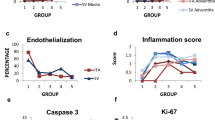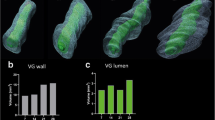Abstract
Neointimal hyperplasia, transplant rejection and thus immunogenicity of allografts are possible reasons for poorer patency rates in cryopreserved venous allografts for peripheral bypass surgery in comparison with autologous venous grafts. To expand the limited knowledge from human allografts, we histologically investigated allogeneic and autologous venous grafts in arterial location. Specimens of allogeneic and autologous venous graft stenosis, harvested 6 months after bypass implantation, were immunohistochemically characterized. Examination of the lesions showed a uniform morphological pattern. A continuous endothelial layer, tissue fibrosis and a thickened neointima with monocytes and dedifferentiated vascular smooth muscle cells were seen in both conduits with very low cell turnover and the absence of acute and chronic inflammation. Neoangiogenesis with CD34-positive endothelium was abundant in the vessel media. The morphological patterns of allogeneic and autologous neointima formation are similar. Consequently, neointimal hyperplasia in venous grafts may reflect a uniform physiological host response of non-immunological factors with the reasons for poorer clinical outcome of cryopreserved allografts yet to be elucidated.



Similar content being viewed by others
Abbreviations
- PAOD:
-
Peripheral arterial disease
- PTFE:
-
Polytetrafluoroethylene
- VSMC:
-
Vascular smooth muscle cell
- eNOS:
-
Endothelial nitric oxide synthase
- ECM:
-
Extracellular matrix
- VV:
-
Vasa vasorum
- VEGF:
-
Vascular endothelial growth factor
- DSA:
-
Digital subtraction angiography
- DAPI:
-
4,6-Diamidin-2-phenylindol
- EC:
-
Endothelial cell
- CD:
-
Cluster of differentiation
- PECAM1:
-
Platelet/endothelial cell adhesion molecule
References
Barshes NR, Ozaki CK, Kougias P, Belkin M (2013) A cost-effectiveness analysis of infrainguinal bypass in the absence of great saphenous vein conduit. J Vasc Surg 57:1466–1470. doi:10.1016/j.jvs.2012.11.115
Bia D, Zocalo Y, Pessana F, Armentano R, Perez H, Saldias M, Alvarez I (2007) Differential functional coupling between human saphenous cryoallografts and arteries: importance of the arterial type and the biomechanical parameter evaluated. Artif Organs 31:809–818. doi:10.1111/j.1525-1594.2007.00467.x
Bol M et al (2013) Inhibiting connexin channels protects against cryopreservation-induced cell death in human blood vessels. Eur J Vasc Endovasc Surg 45:382–390. doi:10.1016/j.ejvs.2012.12.012
Carpenter JP, Tomaszewski JE (1998) Human saphenous vein allograft bypass grafts: immune response. J Vasc Surg 27:492–499
Collins MJ et al (2012) Therapeutic strategies to combat neointimal hyperplasia in vascular grafts. Expert Rev Cardiovasc Ther 10:635–647. doi:10.1586/erc.12.33
Conte MS (2009) Technical factors in lower-extremity vein bypass surgery: how can we improve outcomes? Semin Vasc Surg 22:227–233. doi:10.1053/j.semvascsurg.2009.10.004
Conte MS (2010) Challenges of distal bypass surgery in patients with diabetes: patient selection, techniques, and outcomes. J Vasc Surg 52:96S–103S. doi:10.1016/j.jvs.2010.06.015
Damrauer SM et al (2010) A20 inhibits post-angioplasty restenosis by blocking macrophage trafficking and decreasing adventitial neovascularization. Atherosclerosis 211:404–408. doi:10.1016/j.atherosclerosis.2010.03.029
Davies MG, Hagen PO (2011) Reprinted article pathophysiology of vein graft failure: a review. Eur J Vasc Endovasc Surg 42(Suppl. 1):S19–S29. doi:10.1016/j.ejvs.2011.06.013
Faggioli G, Ricotta JJ (1994) Cryopreserved vein homografts for arterial reconstruction. Eur J Vasc Surg 8:661–669
Fahner PJ, Idu MM, van Gulik TM, Legemate DA (2006) Systematic review of preservation methods and clinical outcome of infrainguinal vascular allografts. J Vasc Surg 44:518–524. doi:10.1016/j.jvs.2006.05.037
Farber A, Major K, Wagner WH, Cohen JL, Cossman DV, Lauterbach SR, Levin PM (2003) Cryopreserved saphenous vein allografts in infrainguinal revascularization: analysis of 240 grafts. J Vasc Surg 38:15–21
Giannoukas AD, Labropoulos N, Stavridis G, Bailey D, Glenville B, Nicolaides AN (1997) Pre-bypass quality assessment of the long saphenous vein wall with ultrasound and histology. Eur J Vasc Endovasc Surg 14:37–40
Harris L, O’Brien-Irr M, Ricotta JJ (2001) Long-term assessment of cryopreserved vein bypass grafting success. J Vasc Surg 33:528–532. doi:10.1067/mva.2001.111729
Johnson TR, Tomaszewski JE, Carpenter JP (2000) Cellular repopulation of human vein allograft bypass grafts. J Vasc Surg 31:994–1002. doi:10.1067/mva.2000.105676
Khurana R, Simons M, Martin JF, Zachary IC (2005) Role of angiogenesis in cardiovascular disease: a critical appraisal. Circulation 112:1813–1824. doi:10.1161/CIRCULATIONAHA.105.535294
Kohler TR, Kirkman TR, Clowes AW (1989) The effect of rigid external support on vein graft adaptation to the arterial circulation. J Vasc Surg 9:277–285
Kreienberg P, Cheema M, Chang BB, Paty PS, Roddy SP, Darling RC III (2007) Primary revision of mid-vein stenoses in venous bypass conduits: venous patch versus interposition vein. J Vasc Surg 45:929–934; discussion 934–935. doi:10.1016/j.jvs.2007.01.018
Lacolley P, Regnault V, Nicoletti A, Li Z, Michel JB (2012) The vascular smooth muscle cell in arterial pathology: a cell that can take on multiple roles. Cardiovasc Res 95:194–204. doi:10.1093/cvr/cvs135
Leseche G, Penna C, Bouttier S, Joubert S, Andreassian B (1997) Femorodistal bypass using cryopreserved venous allografts for limb salvage. Ann Vasc Surg 11:230–236
Luo Z, Asahara T, Tsurumi Y, Isner JM, Symes JF (1998) Reduction of vein graft intimal hyperplasia and preservation of endothelium-dependent relaxation by topical vascular endothelial growth factor. J Vasc Surg 27:167–173
Malinska A, Perek B, Buczkowski P, Kowalska K, Ostalska-Nowicka D, Witkiewicz W, Nowicki M (2013) CD68 expression in aortocoronary saphenous vein bypass grafts. Histochem Cell Biol 140:183–188. doi:10.1007/s00418-012-1069-2
Martin RS III, Edwards WH, Mulherin JL Jr, Edwards WH Jr, Jenkins JM, Hoff SJ (1994) Cryopreserved saphenous vein allografts for below-knee lower extremity revascularization. Ann Surg 219:664–670; discussion 670–672
Miller VM, Bergman RT, Gloviczki P, Brockbank KG (1993) Cryopreserved venous allografts: effects of immunosuppression and antiplatelet therapy on patency and function. J Vasc Surg 18:216–226
Mitra AK, Gangahar DM, Agrawal DK (2006) Cellular, molecular and immunological mechanisms in the pathophysiology of vein graft intimal hyperplasia. Immunol Cell Biol 84:115–124. doi:10.1111/j.1440-1711.2005.01407.x
Muller-Schweinitzer E, Striffeler H, Grussenmeyer T, Reineke DC, Glusa E, Grapow MT (2007) Impact of freezing/thawing procedures on the post-thaw viability of cryopreserved human saphenous vein conduits. Cryobiology 54:99–105. doi:10.1016/j.cryobiol.2006.11.006
Murphy GJ et al (2007) Short- and long-term effects of cytochalasin D, paclitaxel and rapamycin on wall thickening in experimental porcine vein grafts. Cardiovasc Res 73:607–617. doi:10.1016/j.cardiores.2006.11.015
Muto A, Model L, Ziegler K, Eghbalieh SD, Dardik A (2010) Mechanisms of vein graft adaptation to the arterial circulation: insights into the neointimal algorithm and management strategies. Circ J Off J Jpn Circ Soc 74:1501–1512
Pusztaszeri MP, Seelentag W, Bosman FT (2006) Immunohistochemical expression of endothelial markers CD31, CD34, von Willebrand factor, and Fli-1 in normal human tissues. J Histochem Cytochem 54:385–395. doi:10.1369/jhc.4A6514.2005
Randon C, Jacobs B, De Ryck F, Beele H, Vermassen F (2010) Fifteen years of infrapopliteal arterial reconstructions with cryopreserved venous allografts for limb salvage. J Vascu Surg 51:869–877. doi:10.1016/j.jvs.2009.11.062
Santo VJ, Dargon PT, Azarbal AF, Liem TK, Mitchell EL, Moneta GL, Landry GJ (2013) Open versus endoscopic great saphenous vein harvest for lower extremity revascularization of critical limb ischemia. J Vasc Surg. doi:10.1016/j.jvs.2013.08.007
Schober A, Weber C (2005) Mechanisms of monocyte recruitment in vascular repair after injury. Antioxid Redox Signal 7:1249–1257. doi:10.1089/ars.2005.7.1249
Shukla N, Jeremy JY (2012) Pathophysiology of saphenous vein graft failure: a brief overview of interventions. Curr Opin Pharmacol 12:114–120. doi:10.1016/j.coph.2012.01.001
Solanes N et al (2004) Cryopreservation alters antigenicity of allografts in a porcine model of transplant vasculopathy. Transpl Proc 36:3288–3294. doi:10.1016/j.transproceed.2004.10.053
Walker PJ, Mitchell RS, McFadden PM, James DR, Mehigan JT (1993) Early experience with cryopreserved saphenous vein allografts as a conduit for complex limb-salvage procedures. J Vasc Surg 18:561–568; discussion 568–569
Westerband A, Gentile AT, Hunter GC, Gooden MA, Aguirre ML, Berman SS, Mills JL (2000) Intimal growth and neovascularization in human stenotic vein grafts. J Am Coll Surg 191:264–271
Wiedemann D, Kocher A, Bonaros N, Semsroth S, Laufer G, Grimm M, Schachner T (2012) Perivascular administration of drugs and genes as a means of reducing vein graft failure. Curr Opin Pharmacol 12:203–216. doi:10.1016/j.coph.2012.02.012
Zehr BP, Niblick CJ, Downey H, Ladowski JS (2011) Limb salvage with CryoVein cadaver saphenous vein allografts used for peripheral arterial bypass: role of blood compatibility. Ann Vasc Surg 25:177–181. doi:10.1016/j.avsg.2010.07.020
Zhang L, Hagen PO, Kisslo J, Peppel K, Freedman NJ (2002) Neointimal hyperplasia rapidly reaches steady state in a novel murine vein graft model. J Vasc Surg 36:824–832
Zilla P et al (2012) Remodeling leads to distinctly more intimal hyperplasia in coronary than in infrainguinal vein grafts. J Vasc Surg 55:1734–1741. doi:10.1016/j.jvs.2011.11.057
Acknowledgments
We thank the IZKF Wuerzburg for funding of the conducted study. We thank to B. Treffny, E. Kleinschrodt and C. Pregitzer for skillful technical assistance. We also thank C. Buehler and C. Tiurbe for their help with tissue sample acquisition and S. Duell for help with patient care. A.B. and U.L. had overall responsibility for the manuscript. E.H. and N.W. helped with data interpretation. R.K. and R.K. helped with data collection, and S.E. beholds final manuscript approval.
Conflict of interest
All authors declare no conflict of interest.
Author information
Authors and Affiliations
Corresponding author
Electronic supplementary material
Below is the link to the electronic supplementary material.
418_2015_1317_MOESM1_ESM.docx
Supplementary Table 1 Patients’ characteristics and outcome after open bypass repair show heterogeneous baseline variables (DOCX 90 kb)
Rights and permissions
About this article
Cite this article
Albert, B., Elena, H., Nicole, W. et al. Neointimal hyperplasia in allogeneic and autologous venous grafts is not different in nature. Histochem Cell Biol 144, 59–66 (2015). https://doi.org/10.1007/s00418-015-1317-3
Accepted:
Published:
Issue Date:
DOI: https://doi.org/10.1007/s00418-015-1317-3




